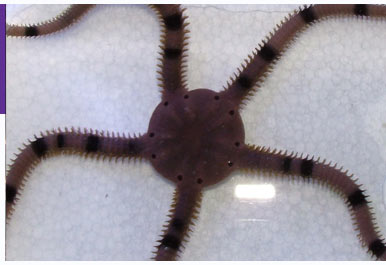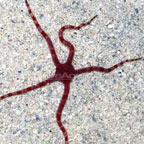Michael Paletta - Guest Author
 |
 |
|
Although they look similar to the sea stars, there are some major morphological differences between these two groups.
Brittle and
Serpent Stars do not possess the groove along the |
underside of their arms and their tube feet serve primarily a sensory function and are not involved in locomotion or the transportation of food to the oral disk. Their arms are much longer and much more differentiated from the central disk and their madreporite is located on the opposite side from that of the sea stars. The light sensory organs (photoreceptors) of brittle and serpent stars also differ from sea stars.
These stars are much more cryptic than their cousins, the sea stars, and do not like to be in bright light. They have specialized photoreceptors that let them know when it is time to come out to feed. They remain hidden in the live rock or substrate until dark to avoid predation, making it very difficult to determine how many brittle stars are present in an aquarium.
 Almost all of these animals possess five arms, with only a few species having more than that. In addition, their arms contain joints and muscles that allow them to move in virtually any direction much more rapidly than their tube-footed cousins. This ability to move on these hinged arms allows these stars to pull themselves into virtually any space. As long as their central disk is not too big, these animals can fit themselves into crevices seemingly too small for them. These flexible arms are used for sensing as well as to latch on to prey, which can include slow moving fish. For this reason, large brittle stars should not be housed with small slow moving fish.
Almost all of these animals possess five arms, with only a few species having more than that. In addition, their arms contain joints and muscles that allow them to move in virtually any direction much more rapidly than their tube-footed cousins. This ability to move on these hinged arms allows these stars to pull themselves into virtually any space. As long as their central disk is not too big, these animals can fit themselves into crevices seemingly too small for them. These flexible arms are used for sensing as well as to latch on to prey, which can include slow moving fish. For this reason, large brittle stars should not be housed with small slow moving fish.
These animals play a crucial role in the long-term maintenance of reef aquariums since they are very active detrivores, living most of their lives hidden within or under live rock consuming any food or waste material that comes their way. Adding some of these animals provides a benefit at a relatively low price. Keep in mind that most of these animals will not become predatory as long as adequate food is provided.
Part 5 of 8. Continue reading:
Part 1
Intro |
Part 2
Unique Chararcteristics |
Part 3
Unique Defense Chararcteristics |
Part 4
Sea Stars (Asteroidea) |
Part 5
Brittle & Serpent Starfish (Ophiuroidea) |
Part 6
Sea Cucumbers (Holothuroidea) |
Part 7
Sea Urchins (Echinoidea) |
Part 8
Feather Stars (Crinoidea) |
Biography
Michael Paletta is the author of two books, "The Modern Marine Aquarium" and "Ultimate Reefs," and has acted as a consultant with the National Aquarium in Baltimore and the Pittsburgh Zoo Aquarium. |





